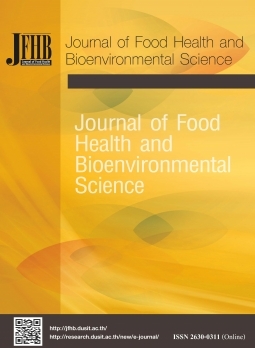The Concentration of Syrup in Making Foi Thong, Med Kanoon, Thong Yip and Thong Yod
Keywords:
Foi ThongMed Kanoon, Thong Yip, Thong YodAbstract
The concentration of syrup that uses egg yolk, boiled into the syrup, as the main ingredient requires the right amount of thickness to make Thai desserts. In this article, Foi Thong, Med Kanoon, Thong Yip and Thong Yod are used and arranged according to the concentrations of syrup with low to high. Starting with Foi Thong which is at 55-57°Brix is round, sticky and glazed. Med Kanoon at 65-66°Brix and is glazed and non-crystalline sugar. Thong Yip is at 70-72°Brix is fluffy, sticky and juicy with syrup. The last one, Thong Yod is at 72-74°Brix has droplet-shape and is non-flat, fluffy, soft and juicy with syrup. The clear syrup is used for soaking Thong Yip and Thong Yod as well as to use to dilute the Foi Thong’s sweetness in cases where the usage of condensed syrup occurs. The above clear syrup should have a concentration of 36-38°Brix. In addition, white sugar applies to this clear syrup. Moreover, using syrup that had a concentration of 60 to 70 g of white sugar to 100 mL of syrup will help enhance osmotic pressure and reduce water activity (αw) which could prevent microbial growth. Most people prefer to use duck egg yolk rather than hen egg yolk for preparing the desserts, due to the greater luster of color, viscosity and oiliness. However, some prefer both duck egg yolk and hen egg yolk mixed, to add a soft texture and lessen the fishy smell of duck egg yolk.
References
A Cuisine. (2019). “Gold dessert” Many stories in the Thai dessert stand. Retrieved April 21, 202 2 from https://acuisineth.com/food-story
Anonymous. (2020). What is a Brix refractometer, and how do they work? Retrieved April 21, 2022 from https://www.instrumentchoice.com.au/news/what-is-a-brix-refractometer-and-how-do-they-work
Bureau of Nutrition, Department of Health, Ministry of Public Health. (2018). Food composition table of Thai foods. Retrieved April 22, 2022 from https://nutrition2.anamai.moph.go.th/th/thai-food-composition-table/download
Bureau of Nutrition, Department of Health, Ministry of Public Health. (2002). Fatty acids composition and cholesterol in Thai foods. Retrieved April 22, 2022 from https://nutrition2.anamai.moph.go.th/th/thai-food-compositiontable/download
Dholvitayakhun, A. (2013). Food experimental (2th ed.). Bangkok: Odeans store.
Ketthongkam, P. (2014). The production of simulated egg yolk for Thong Yoad (Thai dessert) (Master’s thesis). Bangkok: Kasetsart University.
Kyzlink, V. (1990). Principle of preservation. Amsterdam: Elsevier.
Mongkonworawan, K., Jangchud, K., & Wongtong, O. (2002). The effects of syrup concentertion on the qualities of Kha-nom Tongyod, Tongyib and Foytong. In The 40th Academic Conference of Kasetsart University (pp. 454-461). Bangkok: Kasetsart University.
Simons, C. (2022). Properties of water. Retrieved May 1, 2022 from https://cwsimons.com/properties-ofwater
Sinthawalai, S. (1982). Sugar. Retrieved May 1, 2022 from https://sites.google.com/sitexxyphuchsersthkic/khunsmbati-kayphaph-khxng-natal-thray
Suan Dusit Poll. (2021, 7 November). Thai dessert and Thaipeople, Suan Dusit University. Retrieved May 1, 2022 from https://suandusitpoll.dusit.ac.th
The chemistry of textiles, food and surroundings. (2016). The concentration level of syrup in making egg desserts or “Golden Desserts”. Retrieved May 1, 2022 from https://www.facebook.com/textile.phys.and.chem/photos/
Downloads
Published
How to Cite
Issue
Section
License

This work is licensed under a Creative Commons Attribution-NonCommercial-NoDerivatives 4.0 International License.






